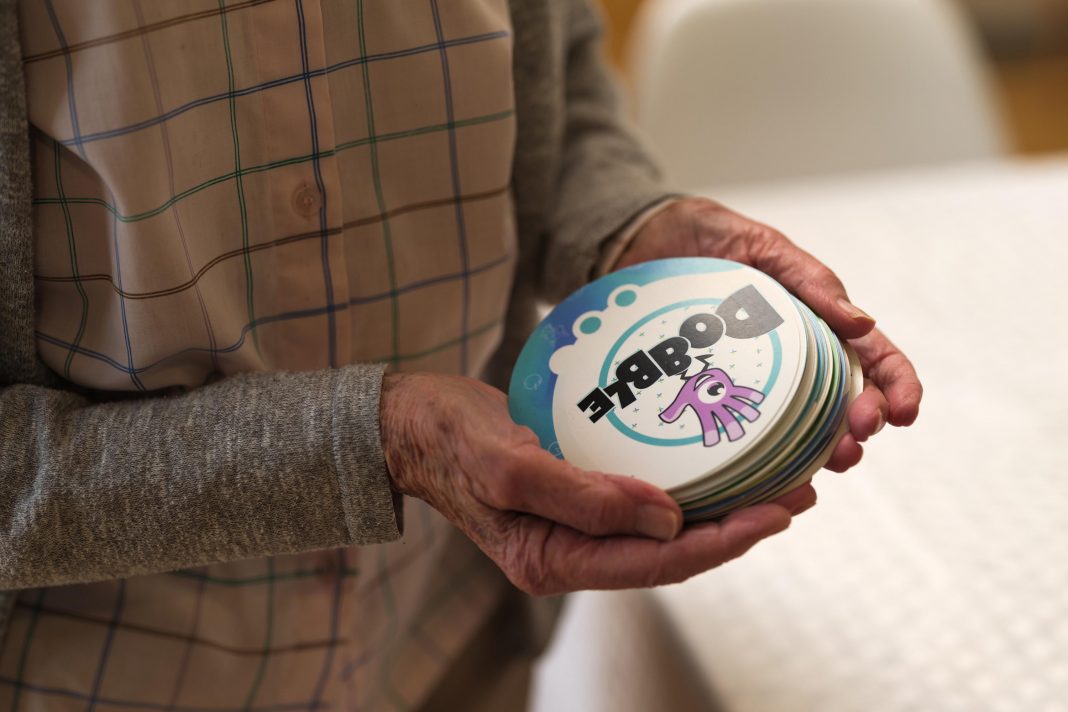Consumer Tech New Asmodee Game Studio Launches Cognitively Accessible Versions Of Its Classic Games Andy Robertson Contributor Opinions expressed by Forbes Contributors are their own. I write about the intersection between technology and family life. May 22, 2022, 03:49am EDT | Share to Facebook Share to Twitter Share to Linkedin Hands holding a set of Dobble / Spot It! cards. Credit: Amosdee Asmodee last week announced its Access+ board game studio that will adapt existing games for players with cognitive disabilities. It draws on clinical data from its research and focuses on making its games more accessible and welcoming for patients, families and caregivers. This will start with Spot It! , Cortex and Timeline. While the long term driver here is accessible and approachable games in general, Asmodee is starting with a specific scenario in mind. Games that accommodate cognitive disabilities in a healthcare environment. It aims to leverage games as a therapeutic tool in healthcare system that offer an easy way for children and carers to play together. To start with this is about approachability and inclusivity for this particular audience, rather than wide ranging accessible in broad terms. I spoke to Mikaël Le Bourhis, head of Asmodee Research to find out more about the studio and its ambitions. “Over several years, Asmodee has invested in scientific research to demonstrate the societal impact board games can have. Now we’re ready to put that research into practice with Access+, creating games that not only are fun to play but provide real, tested benefits to those with special needs, starting with cognitive impairment.” Bourhis explained how these first games draw on research on how games could be more accessible to Alzheimer patients. “We wanted to be focused on cognitive impairments and how reducing these barriers can enables games to stimulate cognitive functions and foster social ties.” MORE FOR YOU Google Issues Warning For 2 Billion Chrome Users Forget The MacBook Pro, Apple Has Bigger Plans Google Discounts Pixel 6, Nest & Pixel Buds In Limited-Time Sale Event You can see this focus in the planned version of Spot It! (also called Dobble in Europe) The Access+ version will offer different levels of difficulty by reducing the items to match on each card. It will also have bigger, thicker cards and ensure all icons are the same size and orientation. These things are designed to make it more accessible from a cognitive perspective. Having worked this year to map board game accessibility for parents , it’s really exciting to see some important aspects being addressed here. The simple and complex versions , and large card size combine with some existing inclusive design aspects of Spot It! like low impact play , clear icons and no text to read during play. I asked Bourhis whether they had considered other impairments in the design, such as motor limitations. “We wanted to be focused on cognitive disabilities initially and for us visual disabilities were another type. This is just the first step of the Access + journey and it needed to be a reachable goal and connected to our healthcare research. If people feel like Access+ products are excellent for them, maybe there would be a way to develop accessibility beyond the cognitive disabilities.” Players hold the Access+ Spot It / Dobble Cards Credit: Asmodee I asked Bourhis about the process of designing the new versions of the games. “We have worked with psychiatrists, healthcare professions, teachers and UX specialists. At each stage of development we have a focus group to share the expertise. It’s a real mix of medical and UX. For me it’s inspiring how video games like The Last Of Us have offered design innovation, and how as a leader of the board game industry we can take this into our future too.” As we talked I was reminded of recent work and discussions with Micheal Heron ( MeepleLikeUs ) to assess Spot It! for my own board game accessible report . While the enhancements that Asmodee+ are bringing will be really useful, there are still areas of visual and motor disability left untouched. For example, if you are colourblind, you can identify the shapes but you are still at a disadvantage in processing the differences as you can’t use colour to enhance and speed up that identification. I asked Heron, who has been working on board game accessibility since 2016, what his thoughts were about this new initiative. “While this is a very positive enterprise, there are tensions in this approach of creating segregated versions of games. I’m also interested to see how the different versions of Spot It! work, as the varied size of shapes was an integral part of the fun. Moving forward, it will be important for Asmodee to work collaboratively with accessibility experts and the community to extend this work into more widely beneficial areas.” It’s clearly an exciting development in the board game world and has generated a number of positive headlines. I too look forward to see where this journey takes the Asmodee Access+ team. But it’s important to be cautious and accurate in the short term about what is on offer here. It’s about approachability and inclusivity for a particular audience rather than an attempt to create fully accessible versions of these games. We aren’t going to be seeing accessible version of Catan and Pandemic any time soon. With Bourhis reference Naughty Dog’s accessibility influence on the wider video game industry it’s clear that Asmodee has set its sights high. It will be fascinating to see where the journey takes them and the level of resource they are able to invest to make it happen. Follow me on Twitter . Check out my website or some of my other work here . Andy Robertson Editorial Standards Print Reprints & Permissions
From: forbes
URL: https://www.forbes.com/sites/andyrobertson/2022/05/22/new-asmodee-game-studio-launches-cognitively-accessible-versions-of-its-classic-games/



